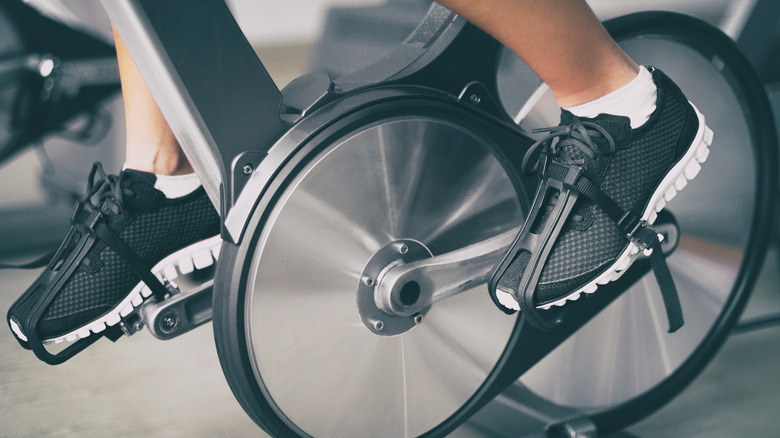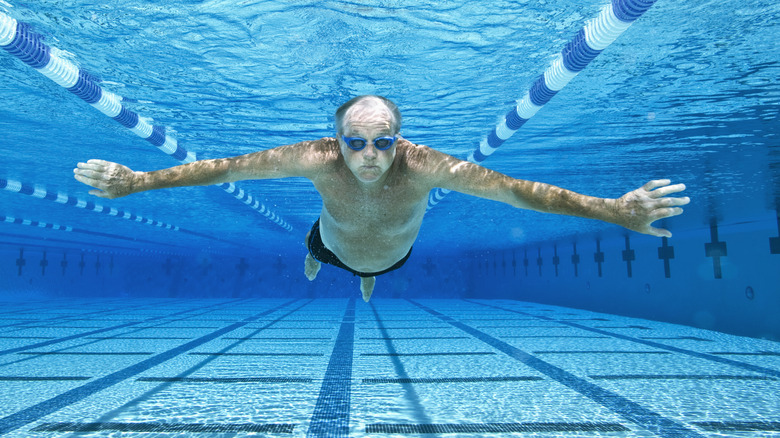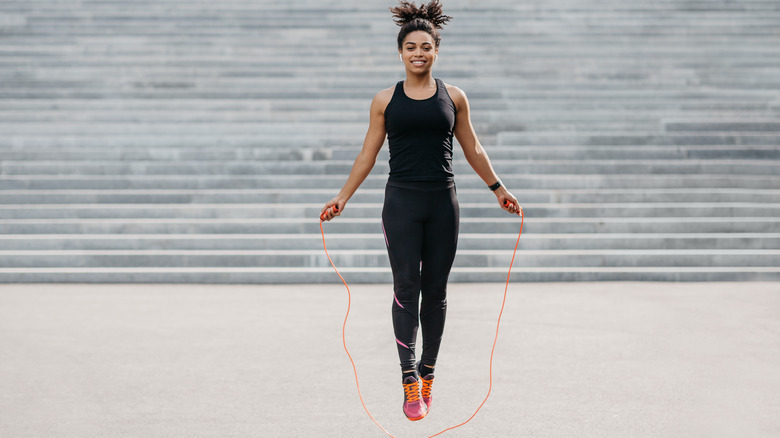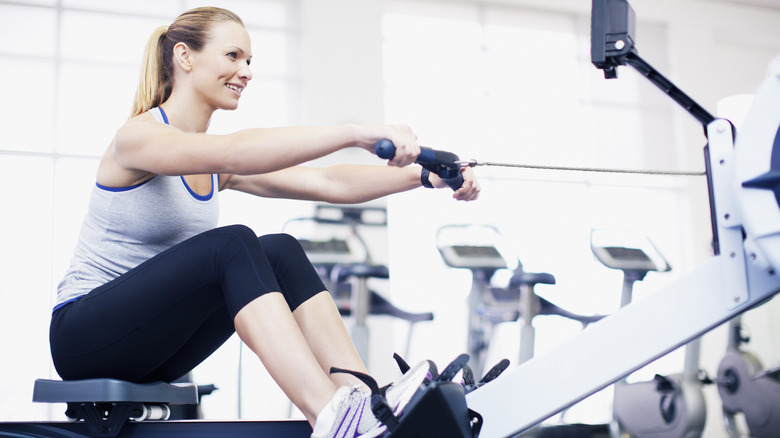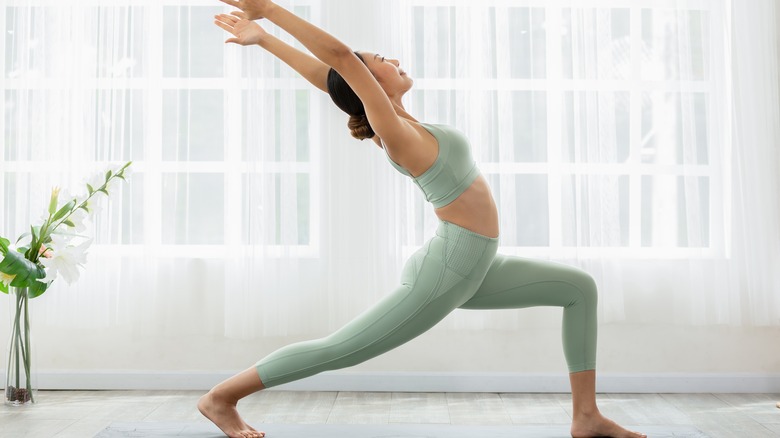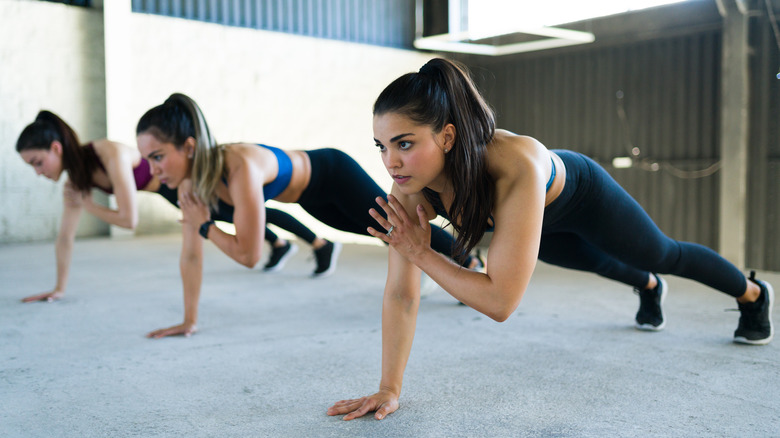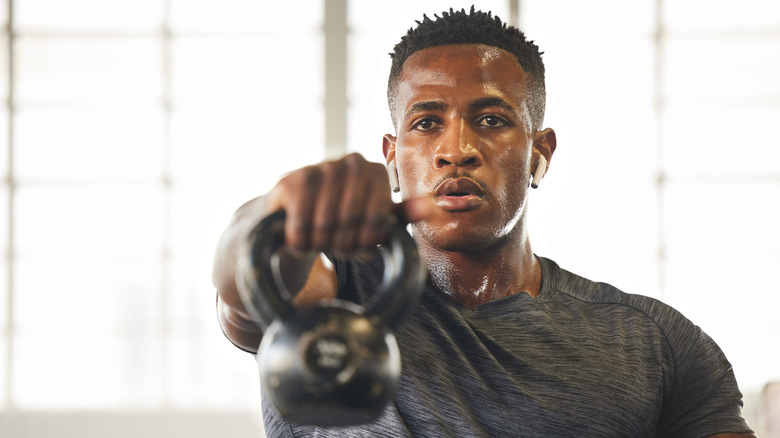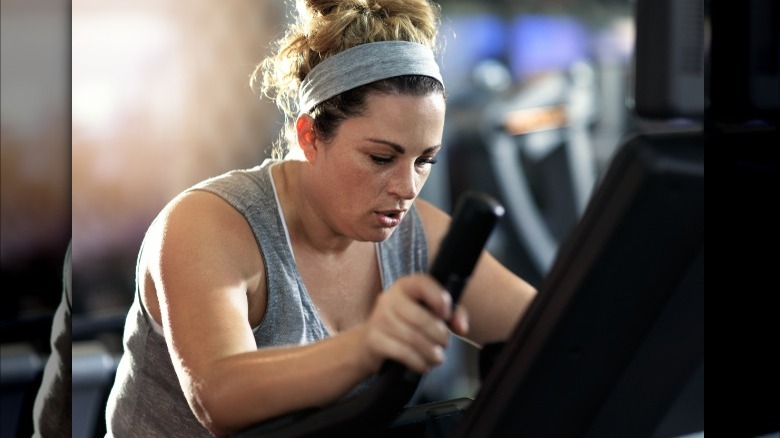Alternatives To Jogging That Burn More Calories
Whether you love it or hate it, running is at the top of the list for fastest calorie-burning exercise (per Health.gov). If you weigh about 150 pounds, you can burn almost 600 calories in an hour by jogging! Though jogging won't actually wreck your knees like you've heard, it can still feel painful on a chilly day and, honestly, it can be an exhausting way to lose weight. Luckily, there's a ton of info on how to get the results you want without the dreaded treadmill.
The best way to burn calories is through regular exercise, but the amount you burn will depend on a few factors: daily stress levels, diet, and weight (per Centers for Disease Control). If you're super stressed out all the time or struggle with an eating disorder, your weight loss and energy levels can be inconsistent. That said, pairing an exercise routine with a steady, balanced diet can help you maintain a healthy weight (per National Institute on Aging).
It will all vary depending on your size (height and weight) and age. The larger you are as a person, the more calories you burn when you exercise (per Mayo Clinic). As personal trainer Daniel Saltos pointed out to Prevention, "If you're 60 and less mobile, then you're not as agile and able to reach as high of an intensity during a workout than if you were an 18-year-old." Below, we've listed out the top calorie-incinerating exercises you can explore as an alternative to jogging.
Cycling
Cycling is a really great option for burning calories because you can do it from pretty much anywhere: home, your local gym, the closest national park, etc. Thankfully, exercise bikes are pretty affordable, too! According to a dietary guidelines report from the U.S. Department of Health and Human Services and the U.S. Department of Agriculture, bicycling at 10 mph burns about the same number of calories (590) per hour as running. That's a lot of calories gone, all in one sitting. You'll be surprised how much of a sweat you can work up!
If you're new to cycling, or it's been a while since you've hit the gym, we recommend taking it slow and working your way up to the full hour over a few weeks so you don't overdo it. If biking outside appeals more to you, make sure you're taking extra precautions on the road, especially at night. Professional cyclist Lael Wilcox told Ladders, "I always have a blinky taillight on my bike in case I get caught riding in traffic after dark. No one in a car wants to hit a cyclist, but we can be hard to see. Visible and reflective clothing can help a lot too, as well as a good headlight."
Hiking
Hiking was also listed on the same report, and although it only burns 370 calories per hour, most hikes usually take longer. You'll have so much to look at, you won't even notice you've hit the three-hour mark until your tummy rumbles for lunch. Three hours of hiking equals more than 1,000 calories burned! If you're not a huge nature fan, you can replicate this with a stiff walk in the city or even on your home treadmill if you really want to. The important part is to get your heart rate up and your muscles working.
The American Hiking Society lists proper footwear as the top must-have item for a successful hike, so make sure you've got a pair of good grippy hiking boots or tennis shoes ready to go before you start your adventure. "The most basic and essential piece of equipment that each hiker should own is good footwear," reads their hiking boots guide. "Break in your footwear with short hikes, going out for a mile or two at first, and then lengthening the hikes as the shoes' comfort increases."
Swimming
If you sweat buckets during cardio or hate the burning-lungs feeling you get after running a mile, you might like swimming better. Rather than lashing yourself to the treadmill or sweating it out in the hot sun, you can exercise your entire body in a cool, comforting underwater environment.
Did you know swimming laps burns up to 510 calories per hour (per Health.gov)? Like hiking, time flies when you're playing mermaids in the pool. You can easily spend two hours (burning over 1,000 calories) in your apartment complex pool before you realize how much you've actually exhausted yourself. If you're intrigued but don't know how to swim, don't sweat it! As one pool industry expert told WDAM, "You're never too old, you're never too young [to learn how to swim]."
Even if your apartment complex or neighborhood doesn't have a community pool, you can usually find one at gyms or public schools in your area. The YMCA, which is well-known for its swimming courses, has locations around the world, which means there's probably one just around the corner from you.
Yard work
Heavy yard work can be a great substitute for running. Next time you have to skip the gym to pull weeds, chop wood, or mow your neighbor's lawn, don't feel bad — you're still putting in the right kind of work! According to Health.gov, vigorous yard work can actually burn upward of 440 calories per hour. Even two hours of nonstop yard work will get you up to almost 900 calories burned. Bonus points if you're getting paid to do it!
Trainer Cat Kom told Well and Good, "Mowing the lawn, like a lot of other yard work, has the potential to be a great workout, depending on your drive and motivation. If you dig deep and push hard, you can get similar benefits as a sled push — high-intensity and low-impact cardio. Plus, you'll be working your back, glutes, hips, core, hamstrings, triceps, shoulders — you name it!"
Just be sure to take breaks and keep good posture. "If you ever feel anything even close to a strain, take a break and pick it up another day," she added.
Jumping rope
It may surprise you to learn that jumping rope, the classic elementary blacktop staple, can burn more calories than your morning run. "Jumping rope can burn upwards of 1,074 calories per hour and is an excellent workout for the whole body," trainer Chris Ryan told The Healthy. "Even just a few minutes of jumping rope can get your lungs burning and heart racing."
Especially if you've enjoyed playing games like Wii Sports, Just Dance, or Beat Saber, you'll crave getting the timing just right with a fun touch like a light-up jump rope.
Another heart-pounding rhythm-based workout to try, jumping rope can tone a variety of muscles, including your back and arms. "Jumping rope recruits all the muscles that strengthen your calves, quads, and glutes along with engaging your shoulders, arms, and core," fitness instructor Wesley Brown told CNET. Like the other exercises on this list, you'll want to stretch and take it slow in the beginning. Before getting started, Brown urged new jump ropers to "perform a few calf raises and establish your breathing pattern" to get warmed up.
Kickboxing
If you're addicted to that adrenaline rush that sprinting gives you, you won't be able to get enough of kickboxing. "Runners experience the phenomenon of a 'runner's high,' and boxing is no different," said boxing coach Tanya Morgan (per Harper's Bazaar). At a whopping 900 calories burned per hour, kickboxing is one of the best ways to work up a sweat (per Revel Sports). It's also a great way to train your fighting spirit, muscles, and overall balance.
"We often don't rely on our legs in our daily lives for more than walking, sitting, and squatting, so when you're starting to kickbox, you're teaching your legs a new way of moving," expert Hali Englert told Women's Health. "Throwing leg strikes while shadowboxing requires your toes, ankles, knees, hips, and core on one leg to rotate, contract, and lengthen all in tandem without a surface like a heavy bag to lean on at the end of the strike if you're off balance." Bonus: she said you don't even need to wear shoes!
Kickboxing is also your next best option for free therapy, since you get to actually punch something. "Punching helps to relieve muscle tension that can collect when you experience stress," Morgan said. "As you continue to punch, you will find your focus is improved, increasing your concentration and helping you forget the reasons why you are stressed." Sounds like the perfect thing to do right after work!
Rowing
There's a reason why rowers tend to look so toned. "It's like combining a leg press, kettlebell swing, and an upper body row all into one cardio-packed exercise," rowing expert Chris Chang said of the popular workout (via Bustle). As you can see from this diagram provided by Wappingers Crew Club, using a rowing machine or taking to the bay with a boat will hit pretty much all major muscle groups. In addition to building muscle faster, you'll also drop extra pounds quickly. According to Revel Sports, an intense rowing workout can burn 800 to 1,100 calories per hour! When you're ready to give it a try, you can easily find a rowing machine at your neighborhood gym or join a local club. There are even a few budget-friendly options for your home gym available online.
When it comes to rowing, keep in mind that less is more. Since you're engaging so many muscles, experts have said it's important to maintain the right posture throughout. "It's common to slouch forward, especially as you get tired," explained trainer Gina Vita (via The Edge). "You set yourself up for low back pain and potential injury." That said, stop short of muscle fatigue if you want to avoid the ice packs and Advil.
Vinyasa yoga
Good news, yoga fans — there's a yoga workout for cardio that doesn't involve hopping on a treadmill or doing jumping jacks! You've heard of hot yoga, but have you tried vinyasa? "Vinyasa yoga is a yoga where the poses are linked together so that there's constant movement," yoga instructor Jesal Parikh explained to SELF. "You are dancing with your breath and movement," Latisha Burgos added. Flowing from one pose into the next creates a circuit, pushing muscles and lungs harder than they would be used during a single pose.
Kaya Health Clubs estimated that this practice can burn somewhere between 500 to 700 calories per hour. Vinyasa has also been proven to decrease stress levels. In a study conducted on college students, researchers found that "plasma cortisol was significantly decreased in [the] yoga group after eight-week yoga training," compared with a control group. Cortisol, or "the body's stress hormone" plays a huge part in how we feel (per National Library of Medicine). Simply put, lower levels can mean less stress. Participants also reported more positive interactions with others and better self-acceptance after these sessions.
HIIT
Have you ever seen a trainer yell at a group of people as they do sprints or situps at the gym? They were probably doing high-intensity interval training (HIIT), a super-intense, short workout. "Interval training was first introduced in the 1950s as a higher intensity form called sprint interval training, which reached 100% maximum heart rate and was used to improve the performance of elite Olympic athletes," explains the Harvard School of Public Health. "Body weight can be used as the main form of resistance so that additional equipment is not needed." This means anyone can do this without needing a gym membership.
Tabata, a popular version of HIIT, is worth mentioning. This style, also used for Olympic training, is attributed to Professor Izumi Tabata and offers an even higher-intensity workout (per Harvard School of Public Health). "There are so many versions of HIIT, but traditional Tabata involves pushing yourself for 20 seconds and resting for 10 seconds, for eight rounds or four minutes," trainer Daniel Saltos told Prevention. "On average, a person will burn 400 to 600 calories in 30 minutes."
But it gets even better! Because of a phenomenon called "excess post-exercise oxygen consumption," HIIT helps you burn calories hours after you've put away your exercise mat (per American Council on Exercise). If you want to burn fat while you sleep, essentially, and spend as little time as possible on cardio, HIIT is definitely for you.
Weightlifting
For those who love to lift and live for the gains, we've got a new cardio workout for you to try. Instead of jumping on the treadmill after your set, get ready for some vigorous weightlifting. In case you're wondering what the heck that even looks like, nutritionist and fitness instructor Simon Byrne has a technical breakdown for you (per Bodies By Byrne): "Moderate weight lifting involves training in a hypertrophy range of 60% to 80% of your one rep max for eight to 12 reps and avoids going to muscle failure. Vigorous weight lifting on the other hand involves training at a percentage close to your one rep max while also going to muscle failure and using advanced lifting techniques."
He went on to say a majority of your lifting should be more in the moderate range, to balance out your overall endurance strength. Powerlifting can burn between 360 and 504 calories per hour, so you can still get your cardio in without ever having to leave the bench (via Medical News Today).
Skating
Ready to bust out your old roller skates? Now's the time! Thanks to TikTok influencers like Ana Coto, this '80s favorite is having another big moment. Renewed interest in skates first spiked on Google in 2020; even in 2022, roller skate sales for some businesses were still up as much as 1,000% (via WCVB).
As it turns out, gliding around the park, roller rink, or cul-de-sac is a great way to get some cardio in. According to the University of Rochester Medical Center, skating burns about 504 calories per hour for a person weighing 150 pounds. Fitness instructor Vynnessa Smith told Popsugar she's already ditched running for a pair of roller skates: "[Roller] skating is a manual sport, meaning the skater has to put in some serious work and force to get the wheels moving. I was looking for something easier on my joints and started roller skating as an alternative to running."
Even better, you can vary the intensity of your workout and see greater results. "If you're skating at moderate speed, you can burn about 250 calories in a 30-minute session," personal trainer Chelsea Nauratan-Burgos told Popsugar. "However, if you're speed skating, park skating, or dance skating, you can absolutely expect to see the calorie total higher."
Stair climber or elliptical
Like the treadmill, the StairMaster is either hated or loved. According to trainer Adam Friedman, using a stair climber will benefit your glutes, thigh muscles, and quads the most (via Shape). If you're not used to using that muscle group or getting your heart pumping, it's going to feel a little intense at first, which is why we recommend starting off with shorter, slower intervals. The University of Rochester Medical Center calorie burn rate calculator says an hour on a stair climber can burn 432 calories for someone weighing 150 pounds, so to really reach that target of 600 calories per hour, you may need to supplement it with another exercise (or more time).
The elliptical is another great alternative to running for those who want to get that kind of full-body motion without pounding on joints. When asked for a low-impact alternative to running, fitness instructor Jacy Cunningham recommended the elliptical, which keeps you in constant, flowing motion the entire time (via Byrdie). Based on the same calorie burn rate calculator above, using this machine for an hour burns about 650 calories, which ranks well above the calories burned during your treadmill session. A simple elliptical can go for as little as $150, so it's something you can add to your home gym without maxing out your credit card.
Sports (including golf)
One might not consider activities like golf to be much of a workout, but even carrying a full set of clubs around for an hour can burn almost 400 calories (per University of Rochester Medical Center). Two hours on the green is an easy goal, even for beginners, and you'll burn about 800 calories total! Plus, because a large percentage of higher-income earners love golf, the courses usually have some of the best natural backdrops and lush, curated landscapes available for players to enjoy (per Insider).
If fairways aren't your speed, you definitely have other options for getting cardio done outside of the gym. Insider rated soccer and taekwondo, at 937 calories per hour, as the biggest calorie-burning sports, followed by tennis, flag football, and basketball (which burn about 728 calories per hour). Winter sports like skiing, snowshoeing, and hockey are all heavy calorie burners, as well as summer activities like beach volleyball and diving (per University of Rochester Medical Center).
Dancing
We've saved the best for last! One of the most fun ways to burn calories and tone your whole body is to dance. We're talking weekly hip-hop dancing lessons, concerts, and even nights out clubbing with co-workers, which can burn up to around 330 calories per hour (via Health.gov). If you're addicted to festivals, you'll be happy to hear this is by far the best way to burn calories with dance. According to Metro, your favorite annual three-day rave burns over 9,000 calories in total! That seemingly impossible number apparently includes all of the alcohol and junk food you eat too, which means you can enjoy the entire thing guilt-free.
If you want to work out from home, dance workouts from your favorite viral aerobics instructor like The Fitness Marshall, or rhythm games like Just Dance, are perfect for creating a regular routine. As dancer Simone De La Rue pointed out to Harper's Bazaar, the most important thing is to keep moving. "Dance is a total body workout. You are not sitting on a bike and cycling or running or weight training. The idea is the body is long and lean and never at rest, just really burning calories. It's fluid, liquid-like movement, and it's continuous."

